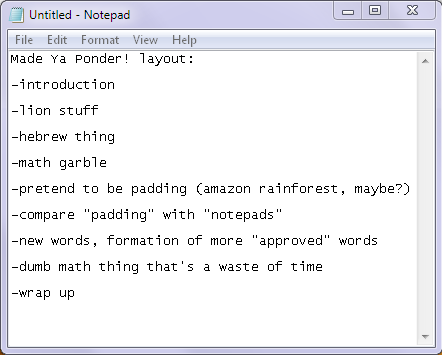Here’s some concepts I realized over my travels that you can use in life or just expand upon. It’s mostly mnemonics. Plus, none of them are enough for their own post. Enjoy!
 So, ever notice how libraries often have statues of lions in front of them? What’s the buzz with that? Well, maybe Spanish has the answer. Or maybe Spanish is a coincidence. I had been taking an online Spanish course for a while and I came across verbs. One of them was how to say “I read.” In Spanish? “Leo.” Yep, the Latin word for “lion” is the same word as “I read.” Coincidence, or a long game pun?
So, ever notice how libraries often have statues of lions in front of them? What’s the buzz with that? Well, maybe Spanish has the answer. Or maybe Spanish is a coincidence. I had been taking an online Spanish course for a while and I came across verbs. One of them was how to say “I read.” In Spanish? “Leo.” Yep, the Latin word for “lion” is the same word as “I read.” Coincidence, or a long game pun?
This next one is for fans of the origin of letters. Hey, the five of you. Ever wonder why “ph” makes an “f” sound? We already have F! The letter “pey” in Hebrew makes a “p” sound. Notice the above image. Pey has a dot called a dagesh in it. What happens if you remove that round thing?
Pey becomes Fey, capable of making F sounds and teaming up with Amy Poehler! And, notice, if you chop of the round part of a P, F is born. This applies similarly to the letters that makes Sh and S, as well as a hard C and Ch.
A math one? But I’m not good at math! Oh well. Complimentary angles are two angles whose sum equals 90 degrees, while supplementary is 180 degrees. Man, that sounds hard to remember. If only the words could help us out! SAY! “Complimentary” has one p, while “supplementary” has two. If we pretend “p” = “9”, then com9limentary is 90, while su99lementary is 9*2, 18, 180 degrees. If you’re bad at spelling too, “complimentary” is before in the alphabet. If you’re bad at alphabetical order, you’re on your own.
Speaking of “on your own,” have you ever been on your own in the Sahara Desert? Not me. I barely know anything about it other than how it’s the go-to example of deserts. If you have, tell me what it’s like. Oh, the fact? No, I’m just padding. Still, let me know about the desert, I am interested.
But you ever notice how “padding” isn’t what you use a notepad for? Padding extends something, even if it shouldn’t. But a notepad is primarily used to shorten ideas to use for later. “Pad” in general is a mixed-up word. Mouse pads ease friction between a mouse and a surface, essentially speeding things up. Lily pads let frogs sit and rest, slowing things down. A home can be referred to as a pad, swinging or otherwise. That’s for rest. There’s pads for your body, to protect. Pad’s all over the map. Who came up with these terms?
Not this guy. He’s a television. Speaking of which, is it just me, or are new words awful? Vaping? The act of inhaling vapor? M-more like “vapid”! How about “binge-watch,” literally taken from “binge” and “watch”? There’s even a dash in-between! Words sure are lazy! I mean all words. “Binge-watch” is as guilty of laziness as “television.” You know, “vision,” the element of seeing, and “tele,” which applies to distance? Tele-phone, “phone” deriving from “phonetic,” tele-gram, far away message, tele-scope, tele-port. Most of our words are just combinations of prefixes and suffixes.
At the end of the day, the real crime binge-watch commits is being too lazy to follow the old rules of lazy. Like, how about “nimispect”? “Nimis” means “excessive,” and “specto” means “to watch,” which sounds slightly better than “binge-watch.” “I’m glad you recommended ‘Two and a Half Men’ to me. I nimispected the whole thing last night.” WOW, there is nothing about that example I like.
Here’s convoluted multiplication I came up with. It’s no help, but kids might like it if for no other reason than math has more “solutions” than they’re taught. Again, though, it’s worthless.
Say you want to multiply 3 and 2 without just adding 3 and 2. All you have to do is add the two, subtract the two, add both numbers, and you get your answer.
3 + 2 = 5
3 – 2 = 1
5 + 1 = 6
See? It’s as simple as it is there. What about without 2 in the equation? 4 * 3, for instance?
4 + 3 = 7
4 – 3 = 1
7 + 1 = 8
8 + 4 = 12
4 being the larger number and 3 being the amount of times you need to use the larger number. For example:
5 + 4 = 9
5 – 4 = 1
9 + 1 = 10
10 + 5 + 5 = 20
Since it’s 5 * 4, 5 is added and subtracted like the others. Add two more fives to get the full four 5’s needed.
See? Pointless. Hey, but at the end of the day, I hope I made ya ponder!






